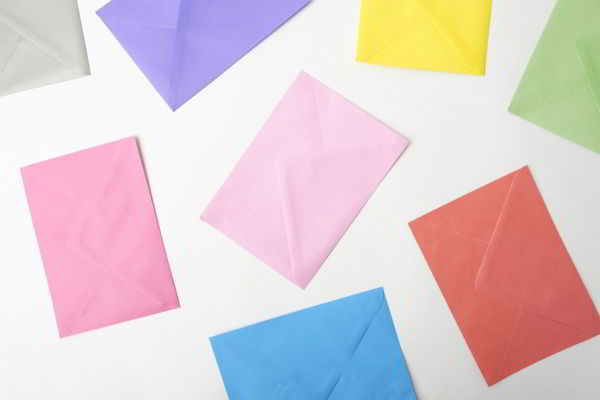Does your business send a lot of important documents through the mail? Read on to learn about 7 different types of envelopes you should consider using.

Letter mail is dying out.
Many prefer the speed and convenience of communicating by email and text message. But technology can’t always replace printed material. From legal documents to brochures, sometimes there’s nothing better than good old-fashioned paper.
If you have paper, you need envelopes too. They’re essential for sending out mail and protecting paperwork.
Your workplace should be well-stocked with several kinds.
What are the different varieties available? Check out our handy guide for everything you should know about using envelopes in your business.
Anatomy of an Envelope
An envelope is a large sheet of paper that’s folded into a pocket. The front, also called the face, is where you’ll put the recipient’s information.
At the back, you’ll find an opening and flaps. The bottom and side flaps come together to form seams. Your main flap closes the envelope. It can either have a triangular shape or a rectangular one. Flaps are located along the short or long edge.
Material
Typical envelopes are made of paper and weigh about 6.75 grams. Paper envelopes are great for most kinds of mail. You can also choose plastic poly mailers or ones made of card stock.
Sending something that needs a lot of protection?
Tyvek envelopes are made of polyethylene fibers. Waterproof and ten times stronger than typical envelopes, they combine the benefits of paper, poly mailers, and card stock.
Types of Envelopes
Now that we’ve got the basic info down, let’s explore seven different business envelopes you should consider using.
Commercial
If you think of a “regular” envelope, you’ve got the commercial. This is your typical white envelope for day-to-day use. Most people grab for the standard 9 1/2 x 4 1/8 size. But it does come smaller and larger as well.
A commercial envelope has two types of flaps: triangular or rectangular. Some flat flaps often come with a peel-and-seal closure.
Choose a commercial for most of your mailing needs. This includes regular mail and interoffice memos. Commercials are also great for sending checks, invoices, and account statements.
Booklet
A booklet envelope has the opening flap along a short, vertical edge. This is different from the commercial, which closes on a horizontal side.
Booklets are typically wider than commercial envelopes. If you’ve got something that can’t be folded, this is the style you need. Some booklets are lined with bubble wrap, to protect fragile items.
Sending out a brochure, booklet, or photograph? This envelope is perfect for the job. The bubble wrap booklet is handy for mailing CDs, DVDs, and small electronics.
Announcement
What happens when you take a booklet envelope and give it a deep triangular (also called baronial) flap? You get the announcement envelope.
Many people recognize these as the envelopes that hold cards. Most are white in color. But you’ll also see pink, blue, yellow, or green in the greeting card aisle.
When you have to send a note, invitation, or card, reach for an announcement envelope. Formal events typically require elegant invitations. In this case, a heavier paperweight will match the tone and style. Don’t forget to ask about color options.
Think of the pocket envelope as a smaller version of the announcement envelope. They have the same wide rectangular shape and baronial flap.
Most envelopes are used to send mail. But the pocket is also handy for storing small items. Use them to protect your passport or traveler’s checks. They’re also handy for organizing receipts, photos, and memos.
Catalog
Preparing a presentation? Store it in a catalog envelope.
You’ll recognize this kind by its large size and the center seam running down the middle. This seam creates durability, making them perfect for heavy materials. Catalogs have a flat flap, sometimes with a clasp to keep them closed.
These large mailing envelopes are big enough to hold a standard piece of paper. You’ll also find super-sized varieties.
Use the catalog for your huge documents. Think insurance policies, manuscripts, and reports. It’s also great for items you don’t want to fold, like resumes, legal documents, and wills.
Window
The next time you receive a bill or check, take a look at your envelope. Chances are, you’ll notice a hole in the front revealing your address. This is a window style.
Window envelopes are useful for showing the document inside. They allow you to save time because you don’t have to print the address twice. Be sure to stock up on these.
Choose a window envelope when you need to mail a letter, check, or invoice. Simply type the recipient’s address at the top, fold, and stuff. You’re all set!
Disc
Have a CD or DVD but no case? A disc envelope has you covered.
These envelopes are a square shape and perfectly fit a disc. A large window in the front is covered with transparent plastic, showing you what’s inside.
Disc envelopes not only protect CDs and DVDs, but they save tons of space. Slip them into a folder or larger envelope where a hard case might not fit. (Note that if you’re mailing a disc, this envelope will not protect it from getting broken. Instead, use a hard case and booklet envelope with bubble wrap.)
Build Your Stock
Now that you’re an envelope expert, put this info to use when ordering your office stationery. Be sure to consider what your needs are and choose the proper type for your operations.
Most businesses can’t go wrong with a supply of commercial, window, and catalog envelopes.
Keen to learn about other essential tools and supplies? Be sure to browse our site for more tips and advice on running a successful business.